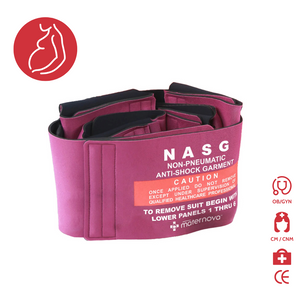
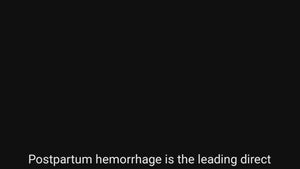
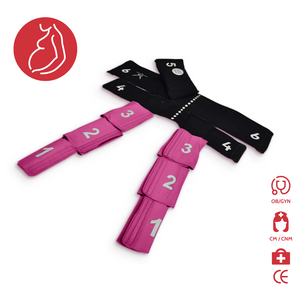
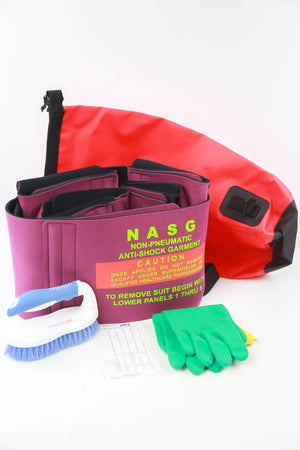
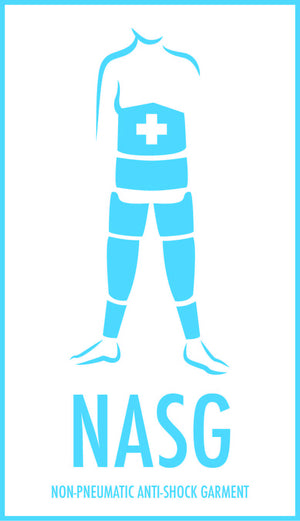
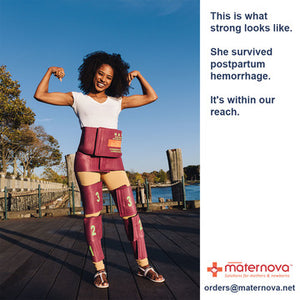

Non-Pneumatic Anti Shock Garment (NASG)
-
- Unique first-aid device, robust, easy to use also in low resource settings
- CE marked, externally used medical device
- Guaranteed high-quality device ensured through careful manufacturing oversight and trusted product delivery (ISO 13485 facility)
- Evidence-based solution to reduce maternal mortality through reversing shock
- Low-cost device, washable, and reusable up to 100 times
- Light-weight, easy to use also during transport within and between health facilities
- WHO and FIGO (International Federation of Gynecologists and Obstetricians) included the NASG in their recommendations for Managing Postpartum Hemorrhage since 2012
- Widely used in UN Agencies including UNICEF, NGOs and by individual clinicians
Non-pneumatic Anti-Shock Garment (NASG)—the Evidence-based, First Aid Device that Reduces Maternal Mortality
The NASG is a low-cost, evidence-based, first-aid device used to stabilize women experiencing obstetric hemorrhage (bleeding before or after childbirth). The NASG is easy to use and can be applied by non-medical people (e.g. members in the community), if they have received basic training on using it. The NASG can be used in everywhere, including low-resource and humanitarian contexts.
The most common type of obstetric bleeding is postpartum hemorrhage. With 1 death every 4 minutes postpartum hemorrhage is the leading cause of death during childbirth globally. A woman can lose her life within hours if she is bleeding and is not provided timely, quality, life-saving care. The risk is even higher if a woman is malnourished or anemic even before labor.
Without intervention, a woman can quickly go into hypovolemic shock (the loss of more than 15% of the body’s blood volume), which can lead to organ failure and even death in a matter of a few hours. Often women die in health facilities that cannot provide the required level of care or during referral to a higher-level facility.
But what if you could ‘buy time’ to stabilize the woman until she reaches a higher level facility and has access to comprehensive care? This is the idea behind the NASG.
How does a Non-pneumatic Anti-Shock Garment work?
The NASG is a lightweight compression suit made of neoprene and closed with Velcro. It has six segments that are wrapped around the woman’s lower body: segments 1-3 compress the legs, segment 4 is around the pelvis, segments 5 and 6 compress the abdomen, with a ball sewn into the abdominal segment to reduce bleeding through uterus and aorta compression. Through the compression, venous blood is pushed from the legs into the blood circulation and helps to provide essential organs (like heart, brain, liver) with oxygen. The NASG can be worn for up to 48 hours, which allows for enough time to treat the causes of the bleeding.
Many approaches to stopping hemorrhage require advanced clinical skills and training. In contrast, the NASG can be applied by a non-medically trained person. The NASG reverses shock and can dramatically improve the odds of survival without any side effects (like infection or laceration).
Product and ordering information
- Minimum quantity of 20 NASGs per order
- English, French, or Spanish Instructions available
- Usage tracking chart included with each order for oversight of usage
- Available globally as
Regulatory approval information
- Recommended by the World Health Organization for managing postpartum hemorrhage.
- Included in FIGO Updates on Management of Postpartum Hemorrhage
- Maternova’s NASG is custom manufactured in an ISO 13485 certified plant specialized in medical devices and medical supplies.
- Maternova’s NASG is CE-marked.
These are not for sale in the United States as of now.
FAQ
When do you use a Non-pneumatic Anti-Shock Garment?
The NASG can be used for all types of obstetric hemorrhage. Obstetric hemorrhage can take place antepartum (before delivery), peripartum (during delivery), with postpartum (after delivery) being the most frequent. Using the NASG especially after delivery is highly recommended when a woman is diagnosed with postpartum hemorrhage. It can also be used during a referral (the transport of a woman to a higher level health facility), to stabilize a woman while she receives medical treatment (e.g. uterotonics) and even during and after vaginal surgery.
The NASG should NOT be placed on a woman before delivery, who still has a viable baby inside her uterus, unless there is no other way to save the woman. Do not use it in pulmonary hypertension, congestive heart failure, mitral stenosis, or in patients with a bleeding above the diaphragm.
How do you use a Non-pneumatic Anti-Shock Garment?
- The NASG is applied best with two people wrapping the leg segments (one person per leg simultaneously) .
- The abdominal segment should be wrapped by one person only.
- Blood pressure and pulse must be monitored frequently.
How do you clean and reuse a Non-pneumatic Anti-Shock Garment?
- The NASG is washed in a light bleach solution and scrubbed with a brush.
- The NASG should be hung outside in the shade, not in direct sunlight.
When to use a Non-pneumatic Anti-Shock Garment:
After the delivery of a newborn, a woman’s blood pressure, pulse and blood loss are monitored routinely. If there are signs for extensive bleeding (estimated blood loss of 500 ml or more) the provider is recommended to call a senior for help and start the management for postpartum hemorrhage. Next to insertion of iv fluid, iv uterotonics (usually Oxytocin; if not available Misoprostol sublingual) and Tranexamic Acid, the NASG should be applied as a first-aid measure to improve the woman’s chance for survival.
Who can put the NASG on a patient?
The NASG can be wrapped around the woman in the community by a community health worker, ambulance team, medic or midwife. It is an obstetric first aid device meaning that in an emergency, a bystander or family member could also help to apply the device.
Step-by-step use of a Non-pneumatic Anti-Shock Garment:
Step 1: Open the NASG and align it in length, so that segment 4 is around the woman’s pelvis, and segments 5 and 6 on her abdomen.
Step 2: Put the NASG evenly under the women; the dotted line that indicates the midline of the NASG should be aligned with the woman’s spine.
Step 3: Stepwise close segments 1, 2, and 3 both sides simultaneously (1 person on each leg). Note: if segment 1 is above the woman’s ankle then fold it in, and start closing at segment 2.
Step 4: 1 person closes segment 4 (around the pelvis), and segments 5 (with the sewed-in ball) and 6 around the abdomen.
When can I remove the Non-pneumatic Anti-Shock Garment?
The NASG should only be removed once the bleeding has (nearly) stopped, and the woman’s vital signs (pulse and blood pressure) are stable for 2 hours. The removal is gradual (segment after segment, starting with segment1) with a 15 min break between each segment, and careful monitoring of the vital signs. In case the vital signs change significantly, the NASG needs to be quickly reapplied, to prevent shock.
Important: the NASG should only be removed by a midwife, nurse or physician. The person removing the NASG must be a trained health professional and is ideally specifically trained on the correct removal of the NASG.
What size NASG should I order?
The NASG comes in 2 sizes:
- Standard: is the default size and fits nearly all women. In case segment 1 is longer than the woman’s legs, the segment can be folded in, and the closing of the NASG starts at segment 2 around the woman’s calves.
- Small: The Small sized NASG is for women who weigh less than 100 lbs (45 kg) and are recommended to order when the population is generally shorter and lighter.
Is there enough evidence for the effectiveness of the Non-pneumatic Anti-Shock Garment?
There is a significant body of evidence available that shows the effectiveness of the NASG, this includes multiple implementation and comparison studies, and meta-analyses in the Cochrane Library. Before and after studies conducted in different parts of the world revealed a 55% reduction in maternal mortality, 80% reduction in blood loss, emergency hysterectomy decreased from 8.9% to 4.0%, and severe adverse outcomes lessened from 12.8% to 4.1% due to the application of NASG.
The WHO and FIGO recommend its use as part of the management of PPH treatment and leading organizations like UNICEF, promote the use of the NASG.
Citations
The guidelines and evidence based studies include:
- International Federation of Gynecologists and Obstetricians (FIGO):
- FIGO recommendations on the management of postpartum hemorrhage 2022.Escobar M., Nassar A., Theron G., Barnea E., Nicholson W., Ramasauskaite D., Lloyd I., Chandraharan E., Miller S., Burke T., Ossanan G., Carvajal J., Ramos I., Hincapie M., Loaiza S., Nasner D., and FIGO Safe Motherhood and Newborn Health Committee, Int J Gynecol Obstet. (2022) Supplement article
-
FIGO’s statement to Save mothers and Stop PPH
https://www.figo.org/news/save-mothers-stop-pph
- Impact of non pneumatic anti shock garment in the management of patients with hypoperfusion due to massive postpartum hemorrhage. Escobar M, Fernández P, Carvajal J, Burgos J, Messa A, Echavarria M, Nieto A, Montes D, Miller S, Hurtado D. (2019) J Matern Fetal Neonatal Med. 2019 Jan 11:1-171.
- The Cochrane Library includes the following study and multiple other studies on the efficacy of the NASG.
- Escobar, M.F., Füchtner, C.E., Carvajal, J.A. et al. Experience in the use of non-pneumatic anti-shock garment (NASG) in the management of postpartum haemorrhage with hypovolemic shock in the Fundación Valle Del Lili, Cali, Colombia. Reprod Health 14, 58 (2017).
Product Materials and Instruction Documents
Maternova Instructions For Use (IFU) are available in French, Spanish and English. For orders of over 500 units, IFU will be translated into other languages. Each booklet includes a tracking sheet for the device to track how many times it has been used.
Example story from the field of recent use
Where is the price?
Pricing is based on shipping location and the number of units ordered. To request a price, please use the Request a Quote button below. A sales representative will respond to you quickly.
- Unique first-aid device, robust, easy to use also in low resource settings
- CE marked, externally used medical device
- Guaranteed high-quality device ensured through careful manufacturing oversight and trusted product delivery (ISO 13485 facility)
- Evidence-based solution to reduce maternal mortality through reversing shock
- Low-cost device, washable, and reusable up to 100 times
- Light-weight, easy to use also during transport within and between health facilities
- WHO and FIGO (International Federation of Gynecologists and Obstetricians) included the NASG in their recommendations for Managing Postpartum Hemorrhage since 2012
- Widely used in UN Agencies including UNICEF, NGOs and by individual clinicians
Non-pneumatic Anti-Shock Garment (NASG)—the Evidence-based, First Aid Device that Reduces Maternal Mortality
The NASG is a low-cost, evidence-based, first-aid device used to stabilize women experiencing obstetric hemorrhage (bleeding before or after childbirth). The NASG is easy to use and can be applied by non-medical people (e.g. members in the community), if they have received basic training on using it. The NASG can be used in everywhere, including low-resource and humanitarian contexts.
The most common type of obstetric bleeding is postpartum hemorrhage. With 1 death every 4 minutes postpartum hemorrhage is the leading cause of death during childbirth globally. A woman can lose her life within hours if she is bleeding and is not provided timely, quality, life-saving care. The risk is even higher if a woman is malnourished or anemic even before labor.
Without intervention, a woman can quickly go into hypovolemic shock (the loss of more than 15% of the body’s blood volume), which can lead to organ failure and even death in a matter of a few hours. Often women die in health facilities that cannot provide the required level of care or during referral to a higher-level facility.
But what if you could ‘buy time’ to stabilize the woman until she reaches a higher level facility and has access to comprehensive care? This is the idea behind the NASG.
How does a Non-pneumatic Anti-Shock Garment work?
The NASG is a lightweight compression suit made of neoprene and closed with Velcro. It has six segments that are wrapped around the woman’s lower body: segments 1-3 compress the legs, segment 4 is around the pelvis, segments 5 and 6 compress the abdomen, with a ball sewn into the abdominal segment to reduce bleeding through uterus and aorta compression. Through the compression, venous blood is pushed from the legs into the blood circulation and helps to provide essential organs (like heart, brain, liver) with oxygen. The NASG can be worn for up to 48 hours, which allows for enough time to treat the causes of the bleeding.
Many approaches to stopping hemorrhage require advanced clinical skills and training. In contrast, the NASG can be applied by a non-medically trained person. The NASG reverses shock and can dramatically improve the odds of survival without any side effects (like infection or laceration).
Product and ordering information
- Minimum quantity of 20 NASGs per order
- English, French, or Spanish Instructions available
- Usage tracking chart included with each order for oversight of usage
- Available globally as
Regulatory approval information
- Recommended by the World Health Organization for managing postpartum hemorrhage.
- Included in FIGO Updates on Management of Postpartum Hemorrhage
- Maternova’s NASG is custom manufactured in an ISO 13485 certified plant specialized in medical devices and medical supplies.
- Maternova’s NASG is CE-marked.
These are not for sale in the United States as of now.
FAQ
When do you use a Non-pneumatic Anti-Shock Garment?
The NASG can be used for all types of obstetric hemorrhage. Obstetric hemorrhage can take place antepartum (before delivery), peripartum (during delivery), with postpartum (after delivery) being the most frequent. Using the NASG especially after delivery is highly recommended when a woman is diagnosed with postpartum hemorrhage. It can also be used during a referral (the transport of a woman to a higher level health facility), to stabilize a woman while she receives medical treatment (e.g. uterotonics) and even during and after vaginal surgery.
The NASG should NOT be placed on a woman before delivery, who still has a viable baby inside her uterus, unless there is no other way to save the woman. Do not use it in pulmonary hypertension, congestive heart failure, mitral stenosis, or in patients with a bleeding above the diaphragm.
How do you use a Non-pneumatic Anti-Shock Garment?
- The NASG is applied best with two people wrapping the leg segments (one person per leg simultaneously) .
- The abdominal segment should be wrapped by one person only.
- Blood pressure and pulse must be monitored frequently.
How do you clean and reuse a Non-pneumatic Anti-Shock Garment?
- The NASG is washed in a light bleach solution and scrubbed with a brush.
- The NASG should be hung outside in the shade, not in direct sunlight.
When to use a Non-pneumatic Anti-Shock Garment:
After the delivery of a newborn, a woman’s blood pressure, pulse and blood loss are monitored routinely. If there are signs for extensive bleeding (estimated blood loss of 500 ml or more) the provider is recommended to call a senior for help and start the management for postpartum hemorrhage. Next to insertion of iv fluid, iv uterotonics (usually Oxytocin; if not available Misoprostol sublingual) and Tranexamic Acid, the NASG should be applied as a first-aid measure to improve the woman’s chance for survival.
Who can put the NASG on a patient?
The NASG can be wrapped around the woman in the community by a community health worker, ambulance team, medic or midwife. It is an obstetric first aid device meaning that in an emergency, a bystander or family member could also help to apply the device.
Step-by-step use of a Non-pneumatic Anti-Shock Garment:
Step 1: Open the NASG and align it in length, so that segment 4 is around the woman’s pelvis, and segments 5 and 6 on her abdomen.
Step 2: Put the NASG evenly under the women; the dotted line that indicates the midline of the NASG should be aligned with the woman’s spine.
Step 3: Stepwise close segments 1, 2, and 3 both sides simultaneously (1 person on each leg). Note: if segment 1 is above the woman’s ankle then fold it in, and start closing at segment 2.
Step 4: 1 person closes segment 4 (around the pelvis), and segments 5 (with the sewed-in ball) and 6 around the abdomen.
When can I remove the Non-pneumatic Anti-Shock Garment?
The NASG should only be removed once the bleeding has (nearly) stopped, and the woman’s vital signs (pulse and blood pressure) are stable for 2 hours. The removal is gradual (segment after segment, starting with segment1) with a 15 min break between each segment, and careful monitoring of the vital signs. In case the vital signs change significantly, the NASG needs to be quickly reapplied, to prevent shock.
Important: the NASG should only be removed by a midwife, nurse or physician. The person removing the NASG must be a trained health professional and is ideally specifically trained on the correct removal of the NASG.
What size NASG should I order?
The NASG comes in 2 sizes:
- Standard: is the default size and fits nearly all women. In case segment 1 is longer than the woman’s legs, the segment can be folded in, and the closing of the NASG starts at segment 2 around the woman’s calves.
- Small: The Small sized NASG is for women who weigh less than 100 lbs (45 kg) and are recommended to order when the population is generally shorter and lighter.
Is there enough evidence for the effectiveness of the Non-pneumatic Anti-Shock Garment?
There is a significant body of evidence available that shows the effectiveness of the NASG, this includes multiple implementation and comparison studies, and meta-analyses in the Cochrane Library. Before and after studies conducted in different parts of the world revealed a 55% reduction in maternal mortality, 80% reduction in blood loss, emergency hysterectomy decreased from 8.9% to 4.0%, and severe adverse outcomes lessened from 12.8% to 4.1% due to the application of NASG.
The WHO and FIGO recommend its use as part of the management of PPH treatment and leading organizations like UNICEF, promote the use of the NASG.
Citations
The guidelines and evidence based studies include:
- International Federation of Gynecologists and Obstetricians (FIGO):
- FIGO recommendations on the management of postpartum hemorrhage 2022.Escobar M., Nassar A., Theron G., Barnea E., Nicholson W., Ramasauskaite D., Lloyd I., Chandraharan E., Miller S., Burke T., Ossanan G., Carvajal J., Ramos I., Hincapie M., Loaiza S., Nasner D., and FIGO Safe Motherhood and Newborn Health Committee, Int J Gynecol Obstet. (2022) Supplement article
-
FIGO’s statement to Save mothers and Stop PPH
https://www.figo.org/news/save-mothers-stop-pph
- Impact of non pneumatic anti shock garment in the management of patients with hypoperfusion due to massive postpartum hemorrhage. Escobar M, Fernández P, Carvajal J, Burgos J, Messa A, Echavarria M, Nieto A, Montes D, Miller S, Hurtado D. (2019) J Matern Fetal Neonatal Med. 2019 Jan 11:1-171.
- The Cochrane Library includes the following study and multiple other studies on the efficacy of the NASG.
- Escobar, M.F., Füchtner, C.E., Carvajal, J.A. et al. Experience in the use of non-pneumatic anti-shock garment (NASG) in the management of postpartum haemorrhage with hypovolemic shock in the Fundación Valle Del Lili, Cali, Colombia. Reprod Health 14, 58 (2017).
Product Materials and Instruction Documents
Maternova Instructions For Use (IFU) are available in French, Spanish and English. For orders of over 500 units, IFU will be translated into other languages. Each booklet includes a tracking sheet for the device to track how many times it has been used.
Example story from the field of recent use







